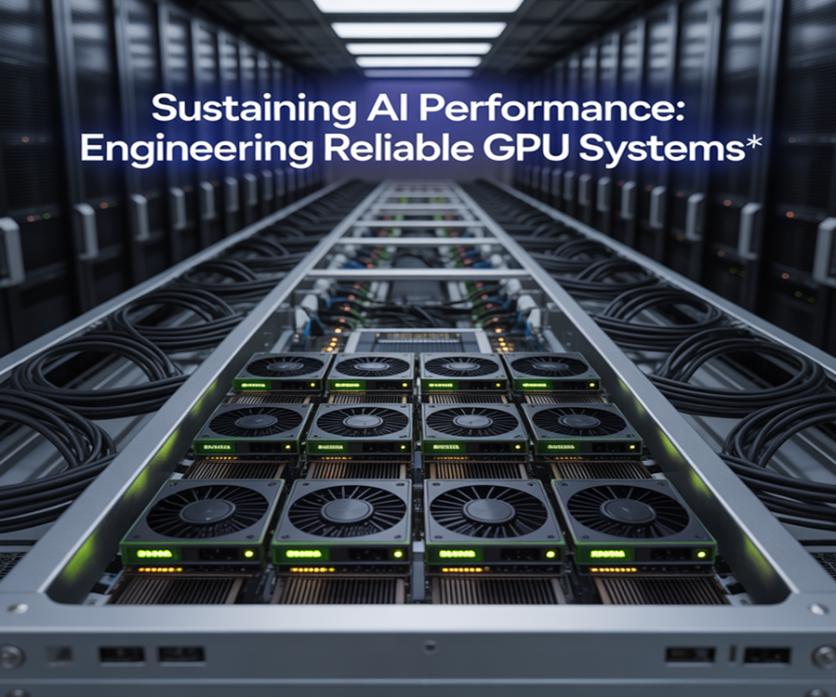
Sameeksha Gupta, an expert in computing systems, proposes a fresh perspective on an overlooked issue in AI infrastructure: GPU reliability in large-scale AI clusters. With a career grounded in advanced AI systems, Gupta brings technical precision and a practical lens to a challenge critical to AI's future.
The Unseen Vulnerability in AI's Backbone
As the AI revolution accelerates, GPUs remain its beating heart, powering models at an unprecedented scale. Yet, this relentless performance has a cost accelerated hardware degradation. Unlike conventional computing, AI workloads place sustained stress on GPU subsystems, exposing failure modes rarely encountered elsewhere. Thermal stress, voltage instability, and memory breakdowns often emerge not in isolation but as interlinked challenges that threaten both performance and long-term reliability.
Thermal Fragility: A Persistent Foe
Heat stands out as one of the most damaging threats. Thermal-related issues, Gupta notes, account for roughly 31% of total GPU malfunctions. These are not mere momentary slowdowns extended heat exposure leads to throttled speeds, material fatigue, and eventual hardware breakdown. AI clusters in high-density racks are particularly susceptible, with elevated inlet air temperatures accelerating this thermal decay.
Voltage Uncertainty and Power Puzzles
Gupta suggests that the dynamic nature of AI workloads rapidly shifting between compute- and memory-heavy operations challenges power delivery systems. Voltage transients during events such as model checkpointing can overwhelm regulators, causing instability or outright failure. A solution lies in decoupling power domains and implementing multi-stage regulation systems to handle these fluctuations more gracefully.
Memory: Where Accuracy Meets Fragility
Memory subsystem failures, while less visible, can be just as disruptive. Even with ECC error correction, sustained high-volume processing can eventually breach safeguards. Gupta points out that newer high-bandwidth memory, though faster, is more thermally sensitive necessitating dedicated cooling solutions. Memory-related issues accounted for 18% of failures, often leading to degraded model accuracy and erratic training behavior.
Failures Born in the Factory
Some vulnerabilities originate before the GPU ever enters service. Silicon-level manufacturing flaws may remain dormant until triggered by the unique computational patterns of AI training. While representing about 13% of failures, these "early-life" breakdowns can undermine infrastructure reliability from the start.
Rethinking Reliability Metrics
Gupta warns that standard uptime measures fail to capture the real impact of degradation. While clusters may report 99% operational availability, effective training availability can dip to 94.7% when reduced throughput and compromised performance are factored in. Additionally, failing GPUs can increase energy use by up to 35% per sample feeding a cycle of higher heat and greater failure risk.
Proactive Solutions: Seeing the Crash Before It Happens
One of Gupta's most forward-looking proposals is a predictive monitoring framework. Instead of reacting to failures, this approach uses metrics such as thermal gradients and memory retry rates to forecast breakdowns. Early tests show 81% accuracy in predicting failures up to three days in advance.
Architecting for Resilience
At the infrastructure level, Gupta suggests separating cooling paths for memory and cores, integrating N+1 cooling redundancies, and designing layouts to minimize hotspot formation. Memory-mirroring across paired GPUs though doubling memory requirements allows seamless failover and uninterrupted training.
Software's Role in Hardware Reliability
Hardware solutions alone are not enough. Gupta proposes software strategies like adaptive checkpointing, where save intervals adjust to system health, and gradient accumulation techniques to tolerate isolated GPU failures helping systems continue training even with partial hardware loss.
Looking Ahead: Closing the Thermal Gap
With GPU power density increasing by about 35% per generation, thermal management is struggling to keep pace. Gupta warns that without architectural innovation, GPU reliability could drop by 20%, with steep operational cost increases. She calls for co-designed hardware-software systems that prioritize resilience alongside raw performance.
In essence, Gupta suggests that reliability must become a core design pillar of AI infrastructure. By embracing predictive maintenance, proactive monitoring, and integrated system design, the AI industry can build systems that are not only faster but also smarter and more durable ensuring that the foundations of the AI future are monuments, not mirages.

-
 C114 Communication Network
C114 Communication Network -
 Communication Home
Communication Home


